Decreasing Pasteurization Treatment Efficiency against Amoeba-Grown Legionella pneumophila—Recognized Public Health Risk Factor
Abstract
1. Introduction
2. Materials and Methods
2.1. Samples and Amoeba Culture
2.2. Microbiological Analyses
2.2.1. Detection and Quantification of Legionella spp. in Water Samples
2.2.2. Determination of Heterotrophic Plate Count (HPC)
2.3. Physical–Chemical Parameters
2.4. Infection of Amoeba with L. pneumophila
2.5. Preparation of Bacterial Suspensions
2.6. Pasteurization Treatments
2.7. Transmission Electron Microscopy (TEM)
2.8. Sequence-Based Typing (SBT) Analysis
2.9. Phenotypic Characterization
2.10. Statistical Analysis
3. Results
3.1. Legionella Prevalence
3.2. Heterotrophic Plate Counts (HPCs) in Relation to the Presence of Legionella
3.3. Influence of Physical and Chemical Factors on Legionella Survival
3.4. Sequence-Based Typing (SBT) and Phenotypic Characterization
3.5. The Growth of Legionella in Amoeba A. castellanii
3.6. Pasteurization Treatment of Agar-Grown and A. castellanii-Grown Legionella
3.7. Cell Morphology
4. Discussion
5. Conclusions
Author Contributions
Funding
Institutional Review Board Statement
Informed Consent Statement
Data Availability Statement
Acknowledgments
Conflicts of Interest
References
- Hsu, T.K.; Wu, S.F.; Hsu, B.M.; Kao, P.M.; Tao, C.W.; Shen, S.M.; Ji, W.T.; Huang, W.C.; Fan, C.W. Surveillance of parasitic Legionella in surface waters by using immunomagnetic separation and amoebae enrichment. Pathog. Glob. Health 2015, 109, 328–335. [Google Scholar] [CrossRef] [PubMed]
- Carvalho, F.R.; Nastasi, F.R.; Gamba, R.C.; Foronda, A.S.; Pellizari, V.H. Occurrence and diversity of Legionellaceae in polar lakes of the Antarctic peninsula. Curr. Microbiol. 2008, 57, 294–300. [Google Scholar] [CrossRef] [PubMed]
- Leung, Y.-H.; Lam, C.-K.; Cheung, Y.-Y.; Chan, C.-W.; Chuang, S.-K. Epidemiology of Legionnaires’ Disease, Hong Kong, China, 2005–2015. Emerg. Infect. Dis. 2020, 26, 1695–1702. [Google Scholar] [CrossRef]
- Tossa, P.; Deloge-Abarkan, M.; Zmirou-Navier, D.; Hartemann, P.; Mathieu, L. Pontiac fever: An operational definition for epidemiological studies. BMC Public Health 2006, 6, 112. [Google Scholar] [CrossRef]
- Helbig, J.H.; Bernander, S.; Castellani Pastoris, M.; Etienne, J.; Gaia, V.; Lauwers, S.; Lindsay, D.; Lück, P.C.; Marques, T.; Mentula, S.; et al. Pan-European study on culture-proven Legionnaires’ disease: Distribution of Legionella pneumophila serogroups and monoclonal subgroups. Eur. J. Clin. Microbiol. Infect. Dis. 2002, 21, 710–716. [Google Scholar] [CrossRef] [PubMed]
- Barker, K.A.; Whitney, E.A.; Blake, S.; Berkelman, R.L. A Review of Guidelines for the Primary Prevention of Legionellosis in Long-Term Care Facilities. J. Am. Med. Dir. Assoc. 2015, 16, 832–836. [Google Scholar] [CrossRef]
- Barrabeig, I.; Rovira, A.; Garcia, M.; Oliva, J.M.; Vilamala, A.; Ferrer, M.D.; Sabrià, M.; Domínguez, A. Outbreak of Legionnaires’ disease associated with a supermarket mist machine. Epidemiol. Infect. 2010, 138, 1823–1828. [Google Scholar] [CrossRef]
- Cowen, K.A.; Ollison, W.M. Continuous monitoring of particle emissions during showering. J. Air Waste Manag. Assoc. 2006, 56, 1662–1668. [Google Scholar] [CrossRef]
- Lin, Y.S.; Stout, J.E.; Yu, V.L.; Vidic, R.D. Disinfection of water distribution systems for Legionella. Semin. Respir. Infect. 1998, 13, 147–159. [Google Scholar]
- Katz, S.M.; Hammel, J.M. The effect of drying, heat, and pH on the survival of Legionella pneumophila. Ann. Clin. Lab. Sci. 1987, 17, 150–156. [Google Scholar] [PubMed]
- Ohno, A.; Kato, N.; Yamada, K.; Yamaguchi, K. Factors influencing survival of Legionella pneumophila serotype 1 in hot spring water and tap water. Appl. Environ. Microbiol. 2003, 69, 2540–2547. [Google Scholar] [CrossRef]
- Ozanic, M.; Marecic, V.; Knezevic, M.; Majstorovic, A.; Zurga, P.; Curlin, M.; Piskur, V.; Lenac, D.; Bulog, A.; Santic, M. The Important Role of Metal Ions for Survival of Francisella in Water within Amoeba Environment. Biomed. Res. Int. 2021, 2021, 6673642. [Google Scholar] [CrossRef]
- Buse, H.; Ashbolt, N.J. The role of biofilms and protozoa in Legionella pathogenesis. J. Appl. Microbiol. 2009, 107, 368–378. [Google Scholar] [CrossRef]
- Kelava, I.; Marecic, V.; Fucak, P.; Ivek, E.; Kolaric, D.; Ozanic, M.; Mihelcic, M.; Santic, M. Optimisation of External Factors for the Growth of Francisella novicida within Dictyostelium discoideum. Biomed. Res. Int. 2020, 2020, 6826983. [Google Scholar] [CrossRef] [PubMed]
- Richards, A.M.; Von Dwingelo, J.E.; Price, C.T.; Abu Kwaik, Y. Cellular microbiology and molecular ecology of Legionella-amoeba interaction. Virulence 2013, 4, 307–314. [Google Scholar] [CrossRef]
- Cirillo, J.D.; Cirillo, S.L.; Yan, L.; Bermudez, L.E.; Falkow, S.; Tompkins, L.S. Intracellular growth in Acanthamoeba castellanii affects monocyte entry mechanisms and enhances virulence of Legionella pneumophila. Infect. Immun. 1999, 67, 4427–4434. [Google Scholar] [CrossRef] [PubMed]
- Fouque, E.; Trouilhé, M.C.; Thomas, V.; Hartemann, P.; Rodier, M.H.; Héchard, Y. Cellular, biochemical, and molecular changes during encystment of free-living amoebae. Eukaryot. Cell 2012, 11, 382–387. [Google Scholar] [CrossRef] [PubMed]
- Kilvington, S.; Price, J. Survival of Legionella pneumophila within cysts of Acanthamoeba polyphaga following chlorine exposure. J. Appl. Microbiol. 1990, 68, 519–525. [Google Scholar] [CrossRef]
- Piao, Z.; Sze, C.C.; Barysheva, O.; Iida, K.-I.; Yoshida, S.-I. Temperature-regulated formation of mycelial mat-like biofilms by Legionella pneumophila. Appl. Environ. Microbiol. 2006, 72, 1613–1622. [Google Scholar] [CrossRef] [PubMed]
- Marchesi, I.; Marchegiano, P.; Bargellini, A.; Cencetti, S.; Frezza, G.; Miselli, M.; Borella, P. Effectiveness of different methods to control legionella in the water supply: Ten-year experience in an Italian university hospital. J. Hosp. Infect. 2011, 77, 47–51. [Google Scholar] [CrossRef] [PubMed]
- De Filippis, P.; Mozzetti, C.; Amicosante, M.; D’Alò, G.L.; Messina, A.; Varrenti, D.; Giammattei, R.; Di Giorgio, F.; Corradi, S.; D’Auria, A.; et al. Occurrence of Legionella in showers at recreational facilities. J. Water Health 2017, 15, 402–409. [Google Scholar] [CrossRef]
- Beauté, J.; Sandin, S.; de Jong, B.; Hallström, L.P.; Robesyn, E.; Giesecke, J.; Sparén, P.; On Behalf Of The European Legionnaires’ Disease Surveillance, Network. Factors associated with Legionnaires’ disease recurrence in hotel and holiday rental accommodation sites. Eurosurveillance 2019, 24, 1800295. [Google Scholar] [CrossRef] [PubMed]
- George, F.; Shivaji, T.; Pinto, C.S.; Serra, L.A.O.; Valente, J.; Albuquerque, M.J.; Vicêncio, P.C.O.; San-Bento, A.; Diegues, P.; Nogueira, P.J.; et al. A large outbreak of Legionnaires’ Disease in an industrial town in Portugal. Rev. Port. Saúde Pública 2016, 34, 199–208. [Google Scholar] [CrossRef][Green Version]
- Rakić, A.; Giljanović, N.; Foglar, L. Monitoring legionella pneumophila in drinking water distribution systems in southern croatia. Fresenius Environ. Bull 2013, 22, 3390–3397. [Google Scholar]
- ISO 11731:2017; Water Quality—Enumeration of Legionella. International Organization for Standardization (ISO): Geneva, Switzerland, 2017.
- ISO 6222:1999; Water Quality—Enumeration of Culturable Micro-Organisms—Colony Count by Inoculation in a Nutrient Agar Culture Medium. International Organization for Standardization (ISO): Geneva, Switzerland, 1999.
- Standard Method 2550 B; 23st ed. Temperature of Water. Standard Methods for the Examination of Water and Waste Water. Amer Public Health Assn (APHA): Washington, DC, USA, 2017.
- ISO 7393-2:2018; Water Quality—Determination of Free Chlorine and Total Chlorine—Part 2: Colorimetric Method Using N,N-diethyl-1,4-phenylenediamine, for Routine Control Purposes. International Organization for Standardization (ISO): Geneva, Switzerland, 2018.
- ISO 7888:1985; Water Quality—Determination of Electrical Conductivity. International Organization for Standardization (ISO): Geneva, Switzerland, 1985.
- ISO 10523:2008; Water Quality—Determination of pH. International Organization for Standardization (ISO): Geneva, Switzerland, 2008.
- Zhang, M.; Gu, L.; Zheng, P.; Chen, Z.; Dou, X.; Qin, Q.; Cai, X. Improvement of cell counting method for Neubauer counting chamber. J. Clin. Lab. Anal. 2020, 34, e23024. [Google Scholar] [CrossRef] [PubMed]
- Knežević, M.; Marečić, V.; Ožanič, M.; Špoljarić, N.; Kelava, I.; Ćurlin, M.; Kwaik, Y.A.; Mihelčić, M.; Šantić, M. Increased Sensitivity of Amoeba-Grown Francisella Species to Disinfectants. Microorganisms 2020, 8, 1260. [Google Scholar] [CrossRef] [PubMed]
- Croze, A.; Carlino, A.; Quélard, B.; Saha, A.; Convert, T.; Eberst, J.B.; Demanèche, S. Intracellular Behaviour of Legionella Non-pneumophila Strains within Three Amoeba Strains, Including Willaertia magna C2c Maky. Pathogens 2021, 10, 1350. [Google Scholar] [CrossRef]
- Gaia, V.; Fry, N.K.; Afshar, B.; Lück, P.C.; Meugnier, H.; Etienne, J.; Peduzzi, R.; Harrison, T.G. Consensus sequence-based scheme for epidemiological typing of clinical and environmental isolates of Legionella pneumophila. J. Clin. Microbiol. 2005, 43, 2047–2052. [Google Scholar] [CrossRef]
- Ratzow, S.; Gaia, V.; Helbig, J.H.; Fry, N.K.; Lück, P.C. Addition of neuA, the gene encoding N-acylneuraminate cytidylyl transferase, increases the discriminatory ability of the consensus sequence-based scheme for typing Legionella pneumophila serogroup 1 strains. J. Clin. Microbiol. 2007, 45, 1965–1968. [Google Scholar] [CrossRef] [PubMed]
- Lück, C.; Fry, N.K.; Helbig, J.H.; Jarraud, S.; Harrison, T.G. Typing methods for legionella. Methods Mol. Biol. 2013, 954, 119–148. [Google Scholar] [CrossRef]
- Teaching Institute of Public Health of Primorje-Gorski Kotar County Database. Legionella. Available online: https://zzjzpgz.hr/publikacije/Legionella_Data_Virul.lence.pdf (accessed on 27 August 2021).
- Allen, M.J.; Edberg, S.C.; Reasoner, D.J. Heterotrophic plate count bacteria—What is their significance in drinking water? Int. J. Food Microbiol. 2004, 92, 265–274. [Google Scholar] [CrossRef] [PubMed]
- Carter, J.T.; Rice, E.W.; Buchberger, S.G.; Lee, Y. Relationships between levels of heterotrophic bacteria and water quality parameters in a drinking water distribution system. Water Res. 2000, 34, 1495–1502. [Google Scholar] [CrossRef]
- D’Alò, G.; Messina, A.; Mozzetti, C.; De Filippis, P. Legionella Detection in Hot Water Distribution Systems of Closed Community and Tourist Accommodation Facilities in the Lazio Region, Italy: Risk Assessment and Prevention. Biomed. Prev. 2018, 2. [Google Scholar] [CrossRef]
- Leoni, E.; Legnani, P.P.; Bucci Sabattini, M.A.; Righi, F. Prevalence of Legionella spp. in swimming pool environment. Water Res. 2001, 35, 3749–3753. [Google Scholar] [CrossRef]
- Ditommaso, S.; Giacomuzzi, M.; Rivera, S.R.A.; Raso, R.; Ferrero, P.; Zotti, C.M. Virulence of Legionella pneumophila strains isolated from hospital water system and healthcare-associated Legionnaires’ disease in Northern Italy between 2004 and 2009. BMC Infect. Dis. 2014, 14, 483. [Google Scholar] [CrossRef]
- Leoni, E.; Catalani, F.; Marini, S.; Dallolio, L. Legionellosis Associated with Recreational Waters: A Systematic Review of Cases and Outbreaks in Swimming Pools, Spa Pools, and Similar Environments. Int J. Environ. Res. Public Health 2018, 15, 1612. [Google Scholar] [CrossRef] [PubMed]
- Doleans, A.; Aurell, H.; Reyrolle, M.; Lina, G.; Freney, J.; Vandenesch, F.; Etienne, J.; Jarraud, S. Clinical and environmental distributions of Legionella strains in France are different. J. Clin. Microbiol. 2004, 42, 458–460. [Google Scholar] [CrossRef][Green Version]
- Lee, H.K.; Shim, J.I.; Kim, H.E.; Yu, J.Y.; Kang, Y.H. Distribution of Legionella species from environmental water sources of public facilities and genetic diversity of L. pneumophila serogroup 1 in South Korea. Appl. Environ. Microbiol. 2010, 76, 6547–6554. [Google Scholar] [CrossRef] [PubMed]
- Sikora, A.; Wójtowicz-Bobin, M.; Kozioł-Montewka, M.; Magryś, A.; Gładysz, I. Prevalence of Legionella pneumophila in water distribution systems in hospitals and public buildings of the Lublin region of eastern Poland. Ann. Agric. Environ. Med. 2015, 22, 195–201. [Google Scholar] [CrossRef]
- Aurell, H.; Etienne, J.; Forey, F.; Reyrolle, M.; Girardo, P.; Farge, P.; Decludt, B.; Campese, C.; Vandenesch, F.; Jarraud, S. Legionella pneumophila serogroup 1 strain Paris: Endemic distribution throughout France. J. Clin. Microbiol. 2003, 41, 3320–3322. [Google Scholar] [CrossRef][Green Version]
- De Filippis, P.; Mozzetti, C.; Messina, A.; D’Alò, G.L. Prevalence of Legionella in retirement homes and group homes water distribution systems. Sci. Total Environ. 2018, 643, 715–724. [Google Scholar] [CrossRef] [PubMed]
- Guyard, C.; Low, D.E. Legionella infections and travel associated legionellosis. Travel Med. Infect. Dis. 2011, 9, 176–186. [Google Scholar] [CrossRef]
- Garrity, G.; Bell, J.; Lilburn, T. Order VI. Legionellales ord. nov. (The Proteobacteria), Part B (The Gammaproteobacteria), 2nd ed.; Springer: New York, NY, USA, 2005; Volume 2. [Google Scholar]
- Dimitriadi, D.; Velonakis, E. Detection of Legionella spp. from domestic water in the prefecture of Arta, Greece. J. Pathog. 2014, 2014, 407385. [Google Scholar] [CrossRef] [PubMed]
- Rakić, A.; Štambuk-Giljanović, N. Physical and chemical parameter correlations with technical and technological characteristics of heating systems and the presence of Legionella spp. in the hot water supply. Environ. Monit. Assess. 2016, 188, 73. [Google Scholar] [CrossRef]
- Tabatabaei, M.; Hemati, Z.; Moezzi, M.-O.S.; Azimzadeh, N. Isolation and identification of Legionella spp. from different aquatic sources in south-west of Iran by molecular & culture methods. Mol. Biol. Res. Commun. 2016, 5, 215–223. [Google Scholar] [CrossRef]
- Lasheras, A.; Boulestreau, H.; Rogues, A.M.; Ohayon-Courtes, C.; Labadie, J.C.; Gachie, J.P. Influence of amoebae and physical and chemical characteristics of water on presence and proliferation of Legionella species in hospital water systems. Am. J. Infect. Control 2006, 34, 520–525. [Google Scholar] [CrossRef]
- Karki, K.; Cann, P.L. Identification of Environmental Factors Involved in Legionella Development. IJIMS 2014, 2, 120–127. [Google Scholar]
- Chiarini, A.; Bonura, C.; Ferraro, D.; Barbaro, R.; Calà, C.; Distefano, S.; Casuccio, N.; Belfiore, S.; Giammanco, A. Genotyping of Legionella pneumophila serogroup 1 strains isolated in Northern Sicily, Italy. New Microbiol. 2008, 31, 217–228. [Google Scholar]
- Borchardt, J.; Helbig, J.H.; Lück, P.C. Occurrence and distribution of sequence types among Legionella pneumophila strains isolated from patients in Germany: Common features and differences to other regions of the world. Eur. J. Clin. Microbiol. Infect. Dis. 2008, 27, 29–36. [Google Scholar] [CrossRef] [PubMed]
- Qin, T.; Zhou, H.; Ren, H.; Guan, H.; Li, M.; Zhu, B.; Shao, Z. Distribution of sequence-based types of legionella pneumophila serogroup 1 strains isolated from cooling towers, hot springs, and potable water systems in China. Appl. Environ. Microbiol. 2014, 80, 2150–2157. [Google Scholar] [CrossRef]
- Trop Skaza, A.; Beskovnik, L.; Storman, A.; Kese, D.; Ursic, S. Epidemiological investigation of a legionellosis outbreak in a Slovenian nursing home, August 2010. Scand. J. Infect. Dis. 2012, 44, 263–269. [Google Scholar] [CrossRef] [PubMed]
- Quero, S.; Párraga-Niño, N.; Barrabeig, I.; Sala, M.R.; Pedro-Botet, M.L.; Monsó, E.; Jané, M.; Sabrià, M.; Garcia-Núñez, M. Population structure of Environmental and Clinical Legionella pneumophila isolates in Catalonia. Sci. Rep. 2018, 8, 6241. [Google Scholar] [CrossRef]
- Linsak, D.T.; Kese, D.; Broznic, D.; Lusic, D.V.; Cenov, A.; Moric, M.; Gobin, I. Sea water whirlpool spa as a source of Legionella infection. J. Water Health 2021, 19, 242–253. [Google Scholar] [CrossRef] [PubMed]
- Hennebique, A.; Peyroux, J.; Brunet, C.; Martin, A.; Henry, T.; Knežević, M.; Santic, M.; Boisset, S.; Maurin, M. Amoebae can promote the survival of Francisella species in the aquatic environment. Emerg. Microbes Infect. 2021, 10, 277–290. [Google Scholar] [CrossRef] [PubMed]
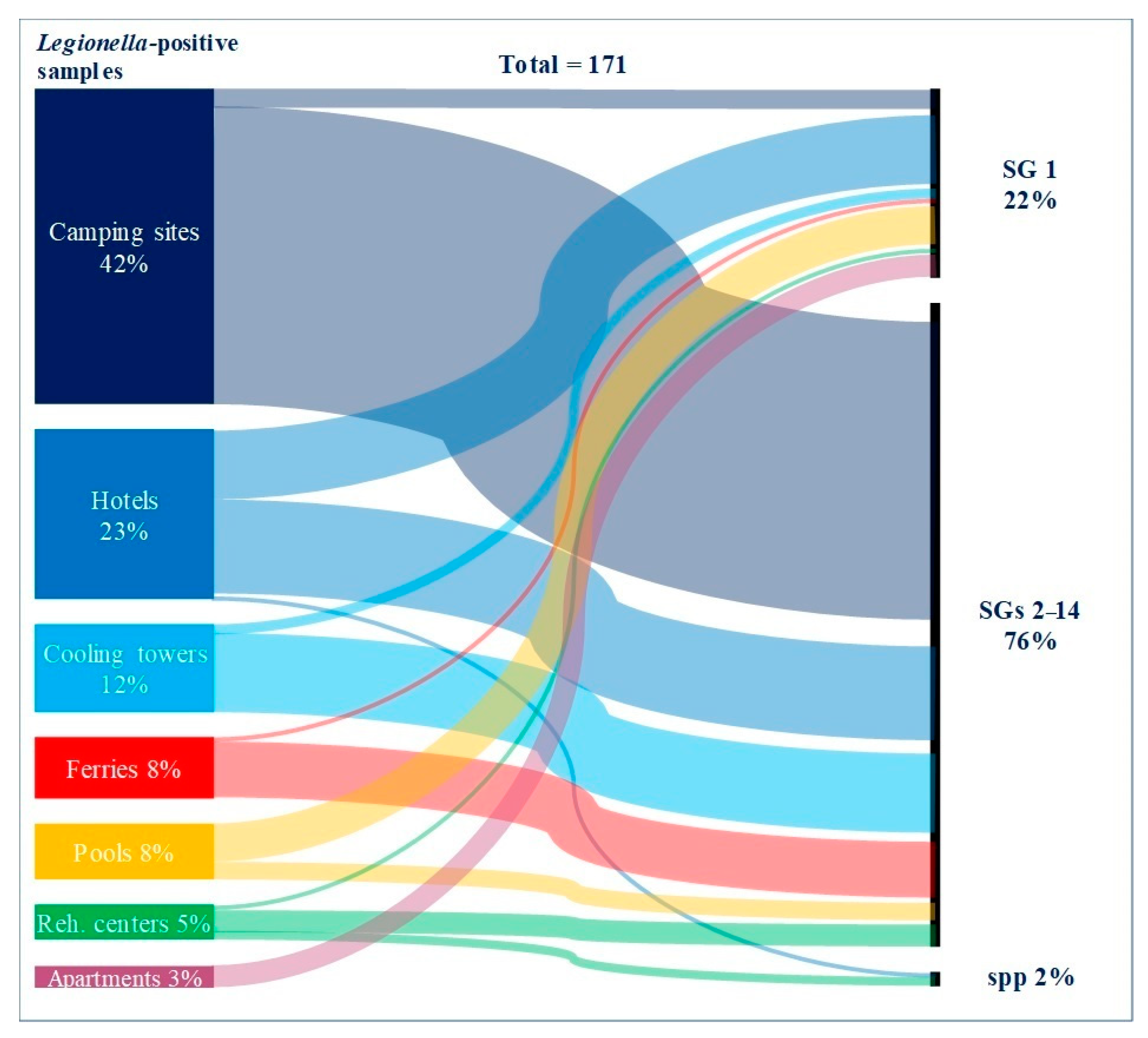

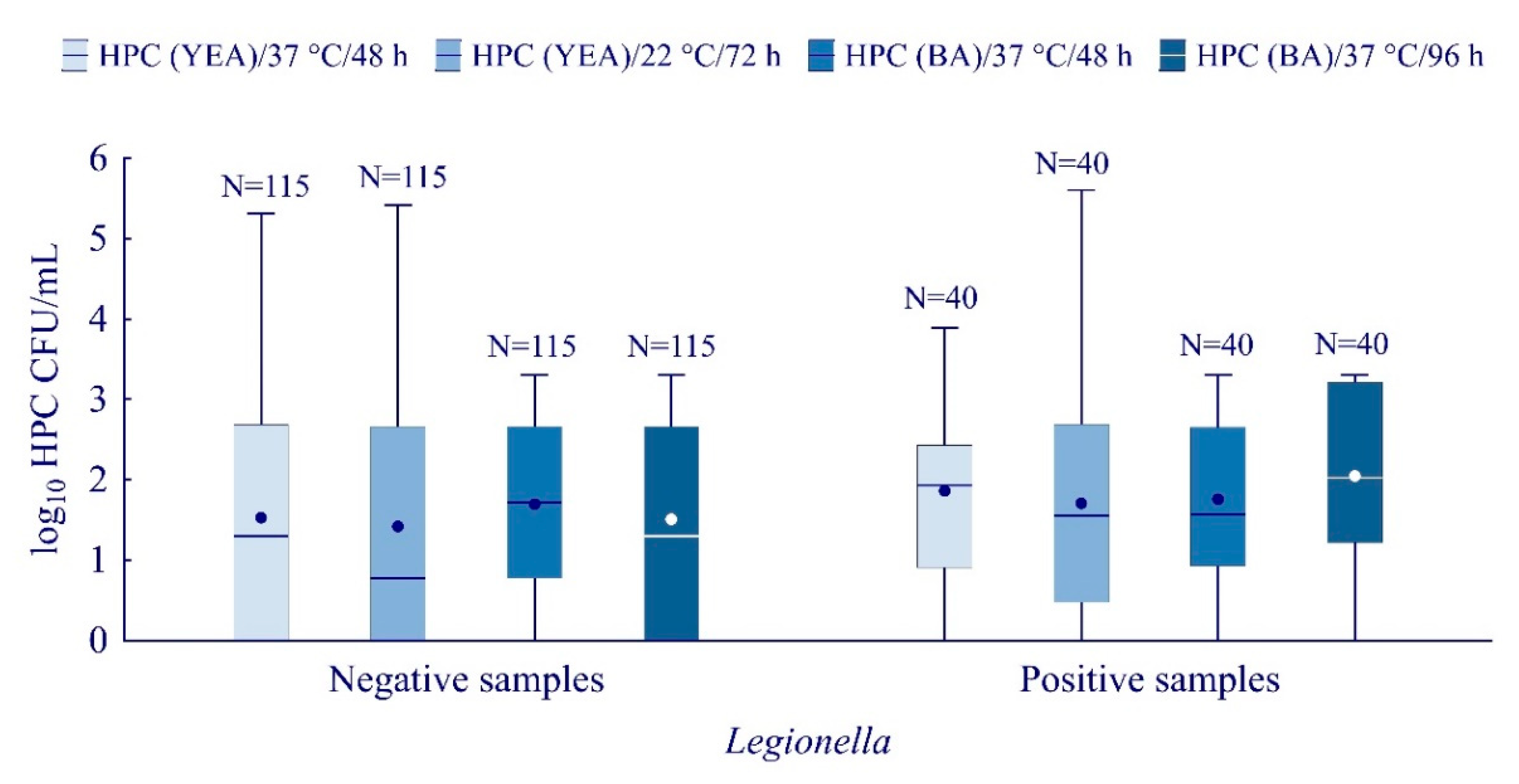
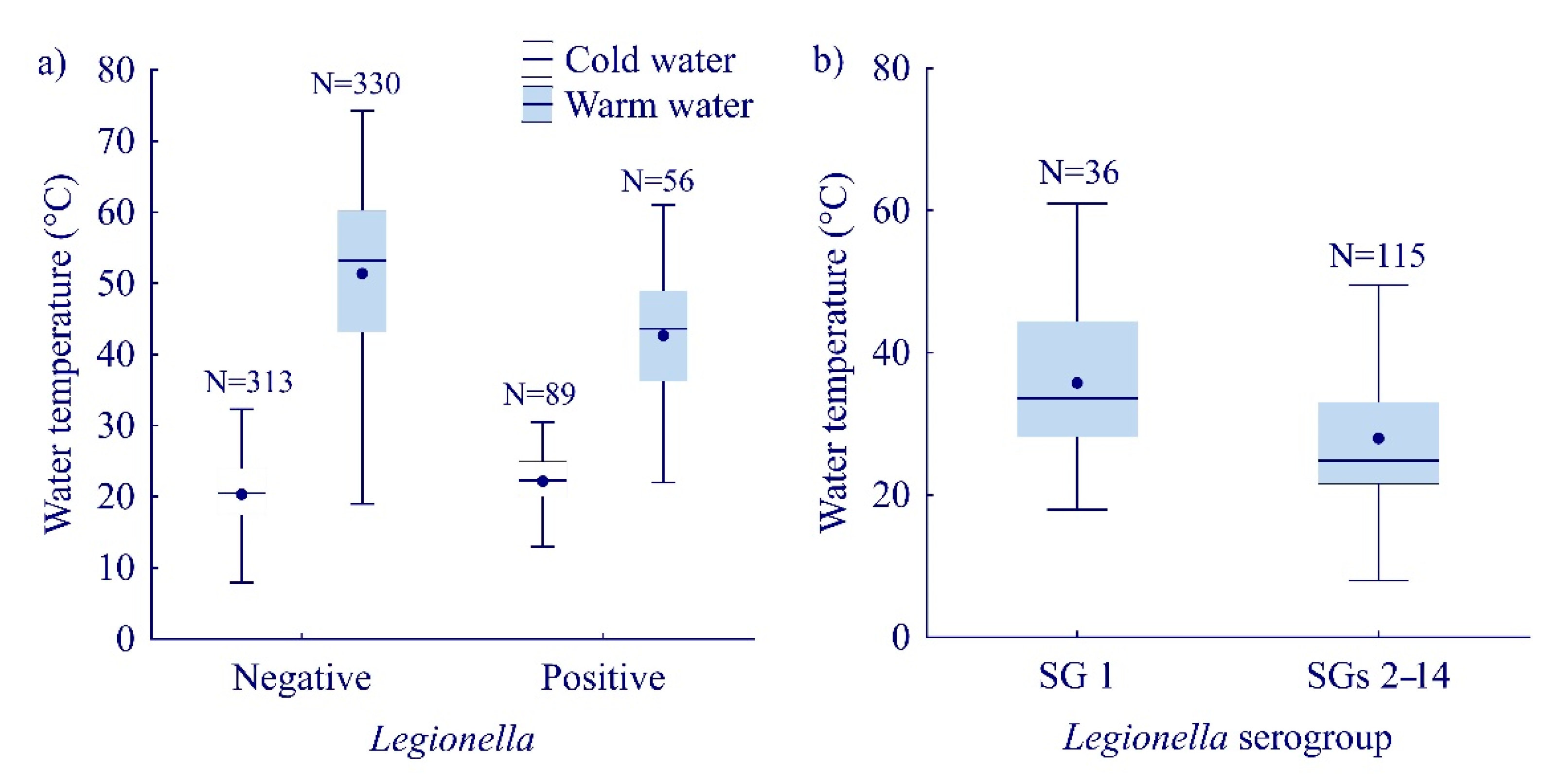
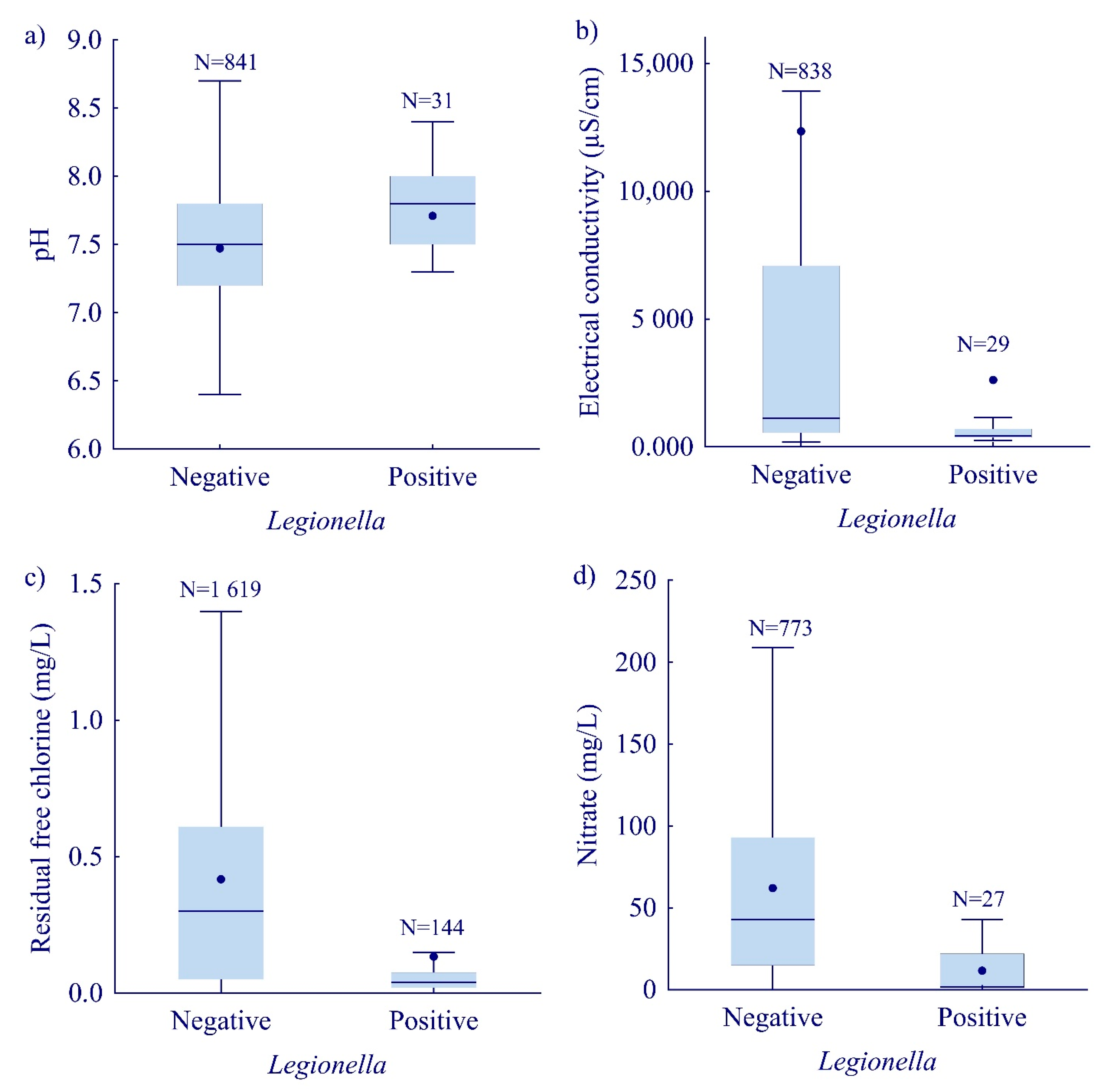
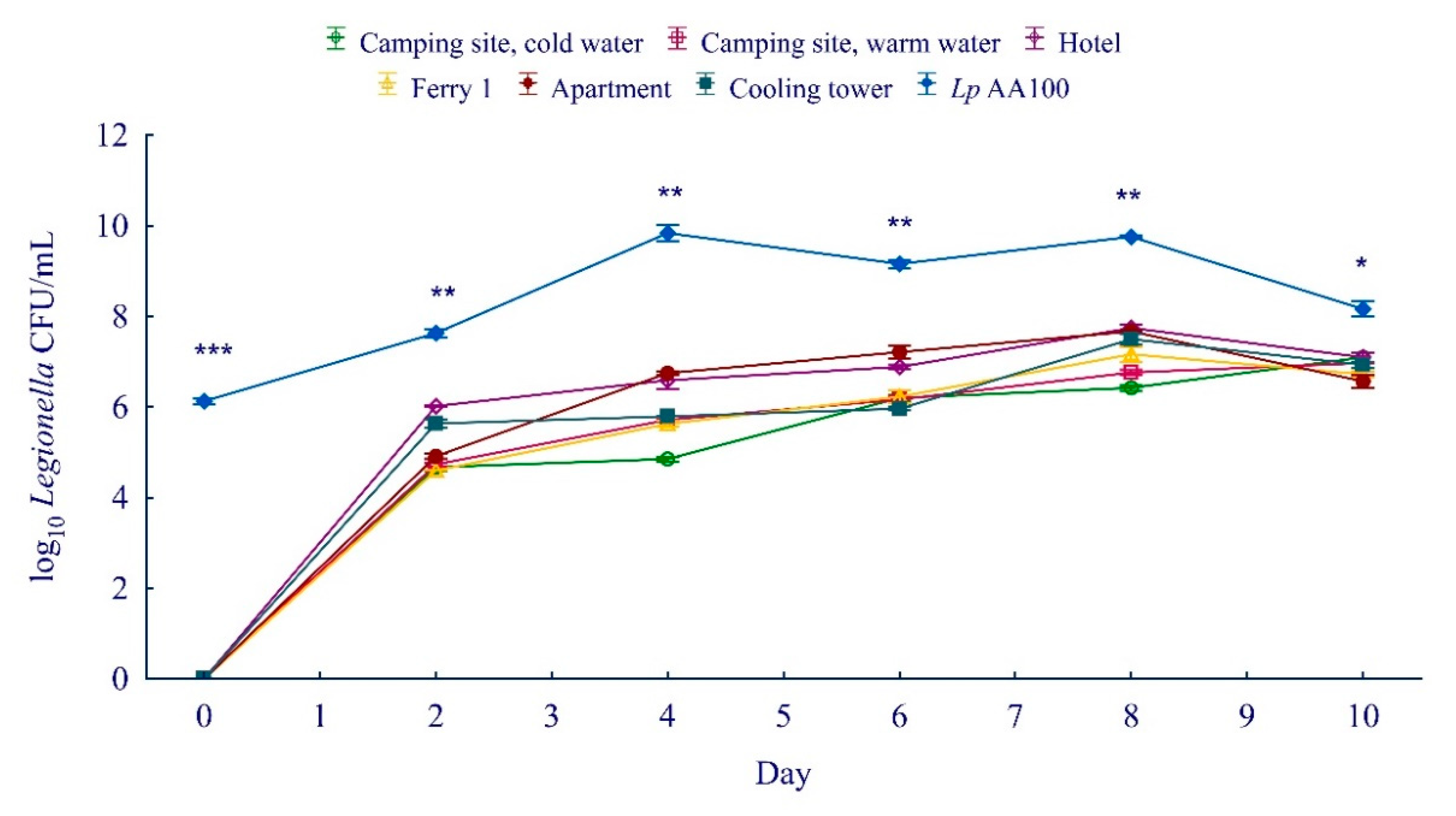
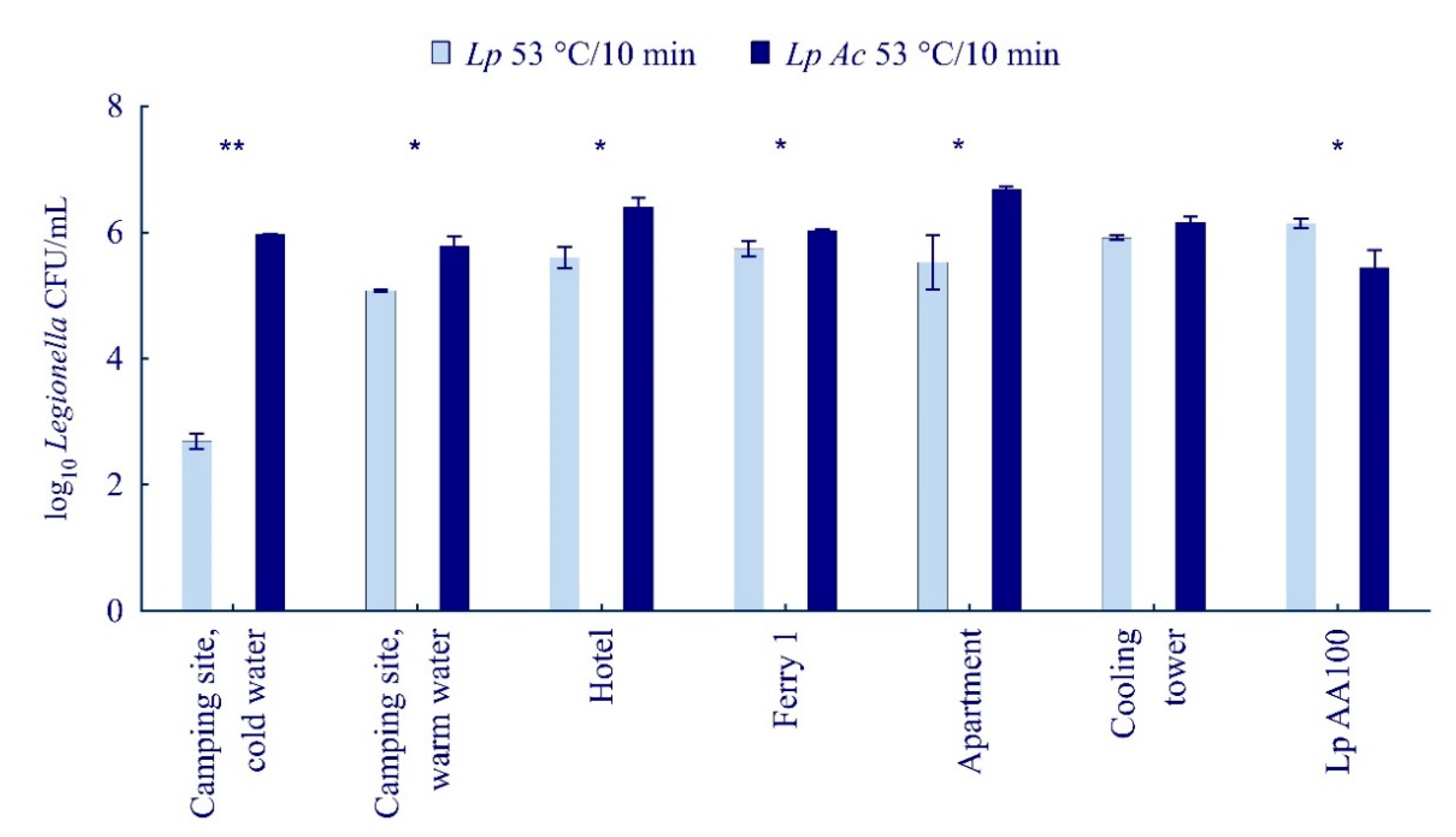
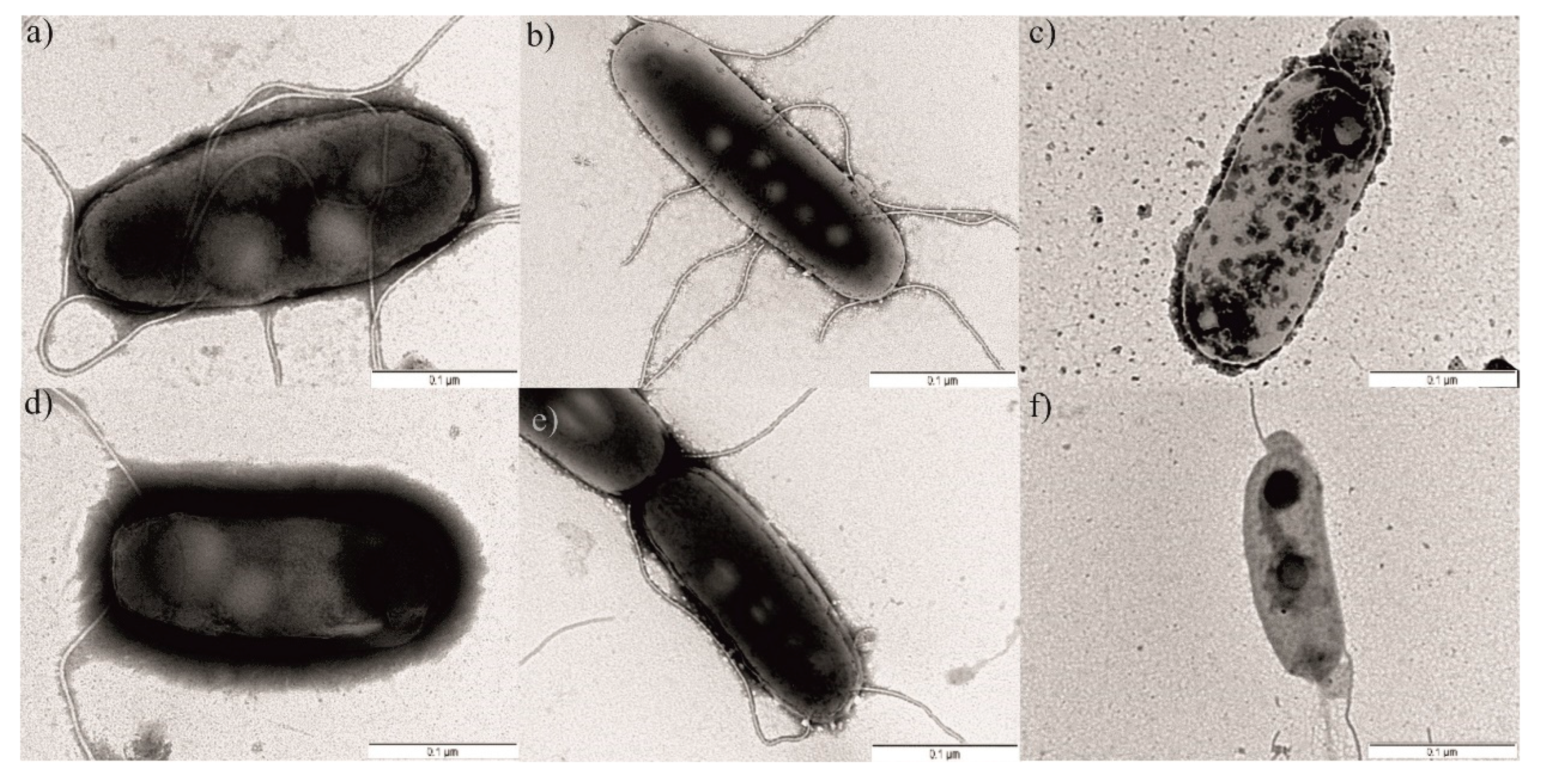
| Year | N | N Legionella Positive | % Legionella Positive |
|---|---|---|---|
| 2013 | 333 | 0 | 0 |
| 2014 | 93 | 0 | 0 |
| 2015 | 96 | 0 | 0 |
| 2016 | 185 | 17 | 9.2 |
| 2017 | 302 | 42 | 13.9 |
| 2018 | 412 | 60 | 14.6 |
| 2019 | 511 | 52 | 10.2 |
| Total | 1932 | 171 |
| Sample | Type of Water Source/Disinfectant | L. pneumophila | Lp SG | ST | Allelic Profile | Phenotype |
|---|---|---|---|---|---|---|
| Hotel | groundwater/ClO2 | isolate from water | 1 | 82 | 5,1,22,10,6,10,6 | Allentown |
| Apartment | surface water | isolate from water | 1 | 62 | 8,10,3,15,18,1,6 | Knoxville |
| Camping site, cold water | surface water/ClO2 + NaClO | isolate from water | 7 | 1317 | 16,21,12,19,31,21,215 | Chicago 8 |
| Camping site, warm water | surface water/ClO2 + NaClO | isolate from water | 7 | 1317 | 16,21,12,19,31,21,215 | Chicago 8 |
| Ferry 1 | groundwater/Cl2 | isolate from water | 7 | 1317 | 16,21,12,19,31,21,215 | Chicago 8 |
| Cooling tower | groundwater/ClO2 | isolate from water | 10 | 1365 | 1,4,3,28,1,1207 | Leiden 1 |
| Ferry 2 | groundwater/NaOCl | isolate from water | 1 | 986 | 1,14,16,16,15,13,2 | Oxford/Olda |
| Wellness | groundwater/Cl2 | isolate from water | 1 | 1 | 1,4,3,1,1,1,1 | Oxford/Olda |
| Rehabilitation Centre | groundwater/ClO2 | isolate from water | 1 | 62 | 8,10,3,15,18,1,6 | Oxford/Olda |
| Hotel, 53 °C/10 min | groundwater/ClO2 | isolate from water- heat treated | 1 | 82 | 5,1,22,10,6,10,6 | Allentown/France |
| Hotel—Lp grown in amoeba | groundwater/ClO2 | isolate from water- grown in amoeba | 1 | 82 | 5,1,22,10,6,10,6 | Allentown/France |
Publisher’s Note: MDPI stays neutral with regard to jurisdictional claims in published maps and institutional affiliations. |
© 2022 by the authors. Licensee MDPI, Basel, Switzerland. This article is an open access article distributed under the terms and conditions of the Creative Commons Attribution (CC BY) license (https://creativecommons.org/licenses/by/4.0/).
Share and Cite
Knežević, M.; Rončević, D.; Vukić Lušić, D.; Mihelčić, M.; Kogoj, R.; Keše, D.; Glad, M.; Cenov, A.; Ožanič, M.; Glažar Ivče, D.; et al. Decreasing Pasteurization Treatment Efficiency against Amoeba-Grown Legionella pneumophila—Recognized Public Health Risk Factor. Int. J. Environ. Res. Public Health 2022, 19, 1099. https://doi.org/10.3390/ijerph19031099
Knežević M, Rončević D, Vukić Lušić D, Mihelčić M, Kogoj R, Keše D, Glad M, Cenov A, Ožanič M, Glažar Ivče D, et al. Decreasing Pasteurization Treatment Efficiency against Amoeba-Grown Legionella pneumophila—Recognized Public Health Risk Factor. International Journal of Environmental Research and Public Health. 2022; 19(3):1099. https://doi.org/10.3390/ijerph19031099
Chicago/Turabian StyleKnežević, Maša, Dobrica Rončević, Darija Vukić Lušić, Mirna Mihelčić, Rok Kogoj, Darja Keše, Marin Glad, Arijana Cenov, Mateja Ožanič, Daniela Glažar Ivče, and et al. 2022. "Decreasing Pasteurization Treatment Efficiency against Amoeba-Grown Legionella pneumophila—Recognized Public Health Risk Factor" International Journal of Environmental Research and Public Health 19, no. 3: 1099. https://doi.org/10.3390/ijerph19031099
APA StyleKnežević, M., Rončević, D., Vukić Lušić, D., Mihelčić, M., Kogoj, R., Keše, D., Glad, M., Cenov, A., Ožanič, M., Glažar Ivče, D., & Šantić, M. (2022). Decreasing Pasteurization Treatment Efficiency against Amoeba-Grown Legionella pneumophila—Recognized Public Health Risk Factor. International Journal of Environmental Research and Public Health, 19(3), 1099. https://doi.org/10.3390/ijerph19031099







